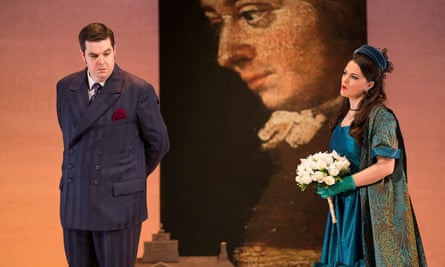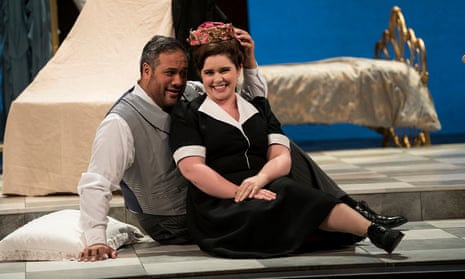A production of the greatest of all operatic comedies is as good a way as any of launching a new opera company. Irish National Opera was created last year at the behest of the Arts Council of Ireland. It opened its doors last month with the touring production of Thomas Adès’s Powder Her Face, first seen a year ago at Northern Ireland Opera. But this new Marriage of Figaro, directed by Patrick Mason, was INO’s first bespoke show, with an opening night last week in Wexford, followed by a run of Dublin performances. Five more productions are planned for the rest of 2018.
The company’s policy is to cast Irish artists as often as possible, and so with the Irish Chamber Orchestra in the pit, conducted by Peter Whelan, the lineup for Figaro included just three “international guests”. Standards were high, and Whelan injected plenty of wiry energy into Mozart’s score, although without any cuts – both Marcellina and Basilio dutifully got their fourth-act arias – it was a long evening.

Mason and designer Francis O’Connor have updated the action to the late 1960s and the last knockings of the Franco regime, when the old order in Spain was about to disappear for ever. It’s an unfussy, non-interventionist reworking, with an airy look that relies on costumes to pin down the period definitively – Cherubino wears flares and Cuban heels, and the chorus of local girls that greet the Count in the third act seem to know all about flower power. A portrait of Mozart (the famous unfinished 1782 one) is ever-present in the background.
But dramatic sparks didn’t always fly as they should, perhaps because, as Figaro and Susanna, Jonathan Lemalu and Tara Erraught made a fairly easygoing couple, both more convincing vocally than dramatically. Ben McAteer was a rather conventionally blustering Count, but there was a bit more grit as the opera went on, especially from Máire Flavin’s Countess – her Dove Sono was the musical highlight of the evening. The real dramatic truthfulness seemed to come from Aoife Miskelly’s beautifully awkward Cherubino, and his flirtations with Barbarina (Amy Ní Fhearraigh); but in this of all operas, the emotional depth and complexity should be more widespread than that.

Comments (…)
Sign in or create your Guardian account to join the discussion